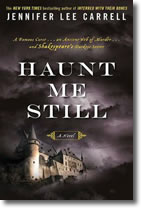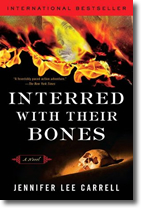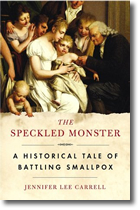Photo by J. B. Byles, in Thomas Francis Ricketts, The Diagnosis of Smallpox
(London: Casell and Company, 1908)
By some scientists’ reckoning, smallpox has killed more people than the Bubonic plague and all of the wars of the twentieth century combined.
- It is highly contagious.
- It is lethal, killing in the realm of 1-in-6 to 1-in-3 of its victims.
“The speckled monster” is an old name for the disease, but it works just as well for the victims, who could become almost unrecognizably monstrous.
It attacked skin and mucous membranes (nose, mouth, throat, anus, vagina) with special ferocity:
- In early stages, the pustules felt like BB pellets buried beneath the skin.
- As the rash intensified, skin felt sheeted in flame; in really bad cases, it just sloughed off.
- Some victims were said to die of thirst rather than enduring the agony of swallowing.
The rash also gave off a particular rotten stench so pungent that experienced doctors could make the diagnosis of smallpox by the smell alone, before ever glimpsing the patient.
For more details, see my post The Course of the Disease (WARNING: graphic photos)
Although there is nothing small about it, smallpox was named “small” to distinguish it from the “Great Pox” — the old folk-name for syphilis. The rashes of syphilis and smallpox can be difficult to distinguish. They are not, however, related.
- Smallpox is viral, caused by the variola virus, and generally spread by breathing.
- Syphilis is bacterial, caused by the spirochete bacterium, and usually sexually transmitted.
These days, syphilis is much less terrifying than smallpox, as it is curable with antibiotics. However, when syphilis first swept across Europe in the early sixteenth century (probably brought back from the Americas by the Spanish), it was incurable and seems to have been much more malign than it is now. For a while, it was as feared in Europe as smallpox.
The syphilis that the Europeans took home from the Americas, however, proved far less lethally destructive than the smallpox that they left behind. By some counts, smallpox was a major contributor to the loss of over 90% of the pre-Columbian American population within a century after first contact.
Under normal conditions, the smallpox virus (variola major) cannot live long outside a human body. By vaccinating every human being within its reach, an army of hundreds of thousands of health workers from all over the world eventually wiped out the virus’s habitat. The last known case was in Somalia, in 1977. In 1980, the World Health Organization declared that smallpox had finally been wiped out.
- Smallpox was the first (and remains the only major) disease that we have eradicated from nature.
- Small amounts of the virus survive in deep-freeze in secure labs in the United States and Russia.
We are luckier than we can possibly know in being able to talk about “the Speckled Monster” in the past tense. Edward Jenner and D. A. Henderson are the most famous figures in the fight against the disease, but we owe a debt of gratitude, as well, to the courage, clear-headed observations and daring of Lady Mary Wortley Montagu and Zabdiel Boylston.
Despite all the horror of this disease, my book The Speckled Monster is a story of courage, heroism, and hope. I hope you will give it a try. Other good books include:
- Fenn, Elizabeth. Pox Americana: The Great Smallpox Epidemic of 1775-82. New York: Hill and Wang, 2001.
- Henderson, D. A. Smallpox: the Death of a Disease: The Inside Story of Eradicating a Worldwide Killer. Foreword by Richard Preston. Amherst, NY: Prometheus Books, 2009.
- Preston, Richard. The Demon in the Freezer: A True Story. New York: Random House, 2002.
- Robertson, Roland G. Rotting Face: Smallpox and the American Indian. Caldwell, Idaho: Caxton Press, 2001.
- Tucker, Jonathan B. Scourge: The Once and Future Threat of Smallpox. New York: Atlantic Monthly Press, 2001.
- Willrich, Michael. Pox: An American History. New York: Penguin, 2011








